

Developer Q&A: The blessing and the curse of early buzz for Rime. In 2013, Rime captivated Gamescom attendees with its debut trailer.

An atmospheric, understated adventure game by indie studio Tequila Softworks, Rime garnered comparisons to masterworks by Eiji Aonuma and Fumito Ueda. While those are flattering comparisons, they put enormous pressure on Rime’s developers, especially when people’s expectations were so distant from what Rime actually aspired to be. It was this pressure that would eventually cause Tequila Softworks to sink into a period of silence starting in 2014. The dev story of PLAYERUNKNOWN'S BATTLEGROUNDS by the general manager Jun Hyuk Choi. The speaker in this piece, Jun Hyuk Choi, is the general manager of Bluehole, who had been involved in Lineage 2, Blade & Souls, and other major MMORPG development at NCSOFT, along with TERA at Bluehole.
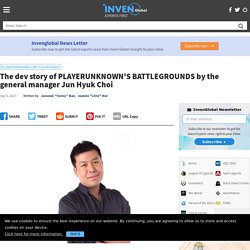
He is one of the core development personnel of PUBG, the viral title that is loved globally. Recently ranked No. 1 after Dota 2 in the top games by concurrent players, and having sold 10 million copies, PUBG is rapidly reaching new heights. The game has become quite a phenomenon, providing players with tons of fun and an odd sense of pride.
Inside the Making of “Mass Effect: Andromeda” – Darryn King. On Wednesday 22 February, there was a curious, disbelieving buzz in the studios of the video game developer BioWare in downtown Montreal.
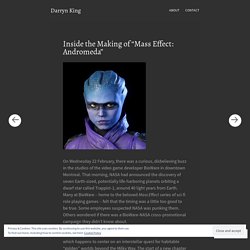
That morning, NASA had announced the discovery of seven Earth-sized, potentially life-harboring planets orbiting a dwarf star called Trappist-1, around 40 light years from Earth. Many at BioWare – home to the beloved Mass Effect series of sci-fi role playing games – felt that the timing was a little too good to be true. Some employees suspected NASA was punking them. Others wondered if there was a BioWare-NASA cross-promotional campaign they didn’t know about.
Ten years ago, the first Mass Effect was hailed as the game that “Does For Games What Star Wars Did For Films”. Ken Levine on Zelda and the terrifying need to demolish the old to make way for the new. Breath of the Wild did something no Zelda game had ever really done before.

It changed. While the world setting and art style had shifted in the past (most notably in Ocarina of Time’s successful move to 3D), the fundamental nature of game flow in Zelda remained unaltered for more than 30 years. Inside Inside. This article contains spoilers for Inside.
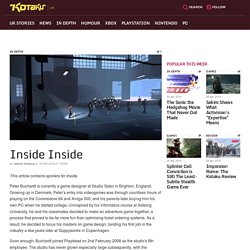
Peter Buchardt is currently a game designer at Studio Gobo in Brighton, England. Growing up in Denmark, Peter’s entry into videogames was through countless hours of playing on the Commodore 64 and Amiga 500, and his parents later buying him his own PC when he started college. Uninspired by his informatics course at Aalborg University, he and his classmates decided to make an adventure game together, a process that proved to be far more fun than optimising ticket ordering systems.
As a result, he decided to focus his masters on game design, landing his first job in the industry a few years later at Guppyworks in Copenhagen. Soon enough, Buchardt joined Playdead on 2nd February 2008 as the studio's 8th employee. The making of Sapienza, Hitman's best level. This article was originally published in PC Gamer issue 299.
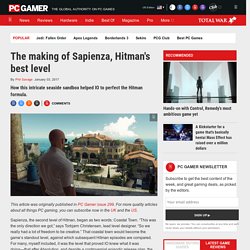
For more quality articles about all things PC gaming, you can subscribe now in the UK and the US. Sapienza, the second level of Hitman, began as two words: Coastal Town. “This was the only direction we got,” says Torbjørn Christensen, lead level designer. “So we really had a lot of freedom to be creative.” That coastal town would become the game’s standout level, against which subsequent Hitman episodes are compared.
How Celeste Was Designed With Speedrunning in Mind. Ratchet & Clank (2016) postmortem. Shaun McCabe is the game director for Ratchet & Clank (PS4), and the production director at Insomniac Games’ studio in Durham, North Carolina.
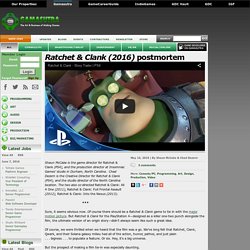
Chad Dezern is the Creative Director for Ratchet & Clank (PS4), and the studio director of the North Carolina location. The two also co-directed Ratchet & Clank: All 4 One (2011), Ratchet & Clank: Full Frontal Assault (2012), Ratchet & Clank: Into the Nexus (2013). How A Small Studio's Chance At The Big Time Died At Microsoft's Doorstep. I see this purely in consulting terms (I’m a consultant).
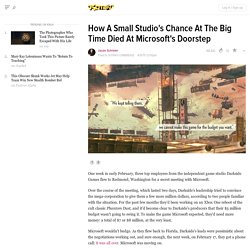
Microsoft here was the client, who outsourced their project to a consultant team (Darkside). They agreed on terms, budget, etc. and work started. Howard Tsao's Blog - Guns of Icarus Online Post-Mortem - Epilogue: How Youtube, Steam, and Our Players Got Us This Far. Guns of Icarus Online Post-Mortem - Epilogue: How Youtube, Steam, and Our Players Got Us This Far The following blog post, unless otherwise noted, was written by a member of Gamasutra’s community.

The thoughts and opinions expressed are those of the writer and not Gamasutra or its parent company. Heeding Christian's Call for blogs on youtube From launch on 10/29/12 through May, 2014, the game has generated over $4.3M with 430K units sold. Postmortem: Monolith Productions' Middle-earth: Shadow of Mordor. Michael de Plater is design director at WB Games studio Monolith Productions.

Middle-earth: Shadow of Mordor shipped worldwide beginning Sept. 30, 2014. Shadow of Mordor was an ambitious game around which we built our current team here at Monolith Productions, and it was the first time many of us had worked together. For the majority of the team it was our first third person, open world action game not to mention our first “new gen” title. This combination of factors made it an enormously educational experience seeing how far we can improve. Postmortem: Naughty Dog's Uncharted: Drake's Fortune. [Naughty Dog calls Uncharted their 'biggest and most complex' challenge yet, and shares successes and stumbles in this fascinating postmortem, originally printed in Game Developer magazine.] At the end of 2004, some of the developers at Naughty Dog (Jak and Daxter, Crash Bandicoot), began work on the studio's first-ever game for the PlayStation 3.
Cryptically assigned the working title Big, the project would prove to be Naughty Dog's biggest and most complex game yet. This postmortem discusses some of the things that we Dogs struggled with, some of our successes and failures, and what we plan to do differently next time. 1. Strong up-front design -- that we can ditch when we need to. Grounded: The making of The Last of Us. The Confessional: It took two years to cancel Singularity, and ten months to fix it. Uncharted: Golden Abyss. Written primarily by writer and director John Garvin, the following incredibly detailed postmortem follows the ins and outs of Sony Bend's development of Uncharted: Golden Abyss, the PlayStation Vita launch title and premier game. Somehow, we managed to pull it off. Not only did we ship on schedule with the hardware, but we were able to hit all of our milestones, including key demos for the 2011 PlayStation Meeting hardware reveal (when the PS Vita was still being called NGP) and the 2011 E3 press conference, where Bend Studio co-director and technical director Chris Reese and I demoed the game live on stage.
Uncharted: Golden Abyss became the PS Vita showcase title, acting as Sony's ambassador to third party developers, media and gamers. It was our job to show what could be done with a next-generation handheld and we delivered. We also think we managed to build a pretty darn good Uncharted game... but it wasn't easy. 1. (Note: Interestingly enough, "Story" is also in What Went Wrong. Prince Of Persia: Sand Of Time. In 2001, a small team within Ubisoft’s Montreal studio led by producer Yannis Mallat began concept development on the project that would become Prince of Persia: The Sands of Time. Initially a consultant, I later joined the team as writer and game designer. Being part of this project was a great experience and I’m glad to revisit it for this book. By its nature, video game writing is inextricably bound up with game design, level design, and the other aspects of production.
Homefront. Spore. A few weeks ago and with little fanfare, Spore turned five-years-old. The game was announced at GDC 2005 during Will Wright’s annual mind-blowing speech on whatever floats through his head. The initial concept – of a game in which the player evolves a species from cellular development to galactic dominion – generated an immense amount of hype, which the game struggled to fulfill upon its 2008 release. Spore received middling reviews from the gaming press, who found the gameplay weak and unfocused, and harsh criticism from the scientific press, who felt tricked by the promise of a game built from real science.
World of Darkness - the inside story on the death of a game. For the video game industry, Monday 14 April 2014 was just another day of layoffs and wasted creative energy. The massively multiplayer online game World of Darkness had spent nine years in development but was being cancelled, and its production studio CCP Atlanta slashed to a sliver of its former size. Fifty-six people lost their jobs.